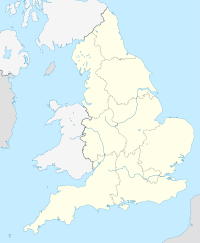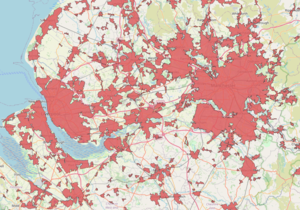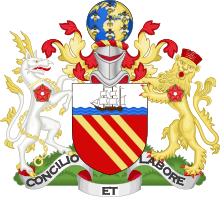
 Map of Built-up areas around Liverpool and Manchester
Map of Built-up areas around Liverpool and Manchester
history [edit ]
industrialization [edit ]
exponential growth and a combine economy has its beginnings during the victorian era, when both cities underwent substantial industrialization. The Liverpool and Manchester Railway in 1830 was a key accomplishment, and was the worldly concern ‘s first inter-city railroad track, [ 6 ] it was besides the beginning railroad track to rely entirely on locomotives driven by steam might, with no horse-drawn traffic permitted at any time ; the first to be wholly double lead throughout its duration ; the first to have a bespeak system ; the foremost to be in full timetabled ; and the first to carry mail. Trains were hauled by company steam locomotives between the two towns, though private wagons and carriages were allowed. cable draw of freight trains was down the steeply-graded 1.26-mile ( 2.03 kilometer ) Wapping Tunnel to Liverpool Docks from Edge Hill junction. The railway was chiefly built to provide faster transmit of natural materials, finished goods and passengers between the Port of Liverpool and the cotton mills and factories of Manchester and surrounding towns. Designed and built by George Stephenson, the course was financially successful, and influenced the development of railways across Britain in the 1830s. In 1845 the railroad track was absorbed by its principal business partner, the Grand Junction Railway ( GJR ), which in turn amalgamated the follow class with the London and Birmingham Railway and the Manchester and Birmingham Railway to form the London and North Western Railway .
 The track network of the North West ‘s largest conurbations – Greater Manchester and Merseyside. Includes the two rapid transportation system systems Metrolink and Merseyrail
The track network of the North West ‘s largest conurbations – Greater Manchester and Merseyside. Includes the two rapid transportation system systems Metrolink and Merseyrail
Manchester Ship Canal [edit ]
Relations between the cities turned bitter after the construction of the Manchester Ship Canal in 1894 by Manchester merchants. The mancunian merchants became disenchanted with the dues they had to pay to import and export goods to and from Manchester. consequently, they decided to build a transport canal, which was the largest ship canal in the populace upon opening in 1894 .
road [edit ]
In 1976 the M62 expressway at the Liverpool goal was completed and opened, connecting Liverpool to Manchester by one expressway.
competition [edit ]
The Liverpool–Manchester rivalry is a competition that exists between the English cities of Manchester and Liverpool. Since the industrial revolution, there has been a coherent competition between the two cities based on economic and industrial contest. Manchester through to the eighteenth century was the far more populous city and was considered representative of the north. By the recently eighteenth century, Liverpool had grown as a major seaport – critical to the growth and success of the northern cotton mills. Over the future hundred, Liverpool grew to supersede Manchester and throughout the former 19th and early twentieth century was often described as the british Empire ‘s moment city. [ 9 ] The links between the two cities were strengthened with the construction of the Bridgewater Canal, the Mersey and Irwell Navigation and the earth ’ mho first inter-city railroad track, the Liverpool and Manchester Railway, for the transport of raw materials inland. [ 10 ] The competition is generally agreed to have ignited after the construction of the Manchester Ship Canal. Manchester merchants became disenchanted with the flat of dues they had to pay to export and import their goods. The construction, funded by Manchester merchants, was opposed by Liverpool politicians and bred resentment between the two cities. The Ship Canal would become the largest in the universe upon opening in January 1894 and highlighted the duration the merchants were prepared to take to avoid paying dues. [ 11 ] nowadays, the crests of both the city of Manchester and Manchester United include stylised ships representing the Manchester Ship Canal and Manchester ‘s barter roots. The ship is besides included on the peak of many other mancunian institutions such as Manchester City Council and rivals Manchester City F.C .
 The Liverpool coat of arms features the fabulous shuttlecock known as the ‘Liver ‘ dame. It is believed to be based on a cormorant. This creature formed the basis of the Liverpool FC badge
The Liverpool coat of arms features the fabulous shuttlecock known as the ‘Liver ‘ dame. It is believed to be based on a cormorant. This creature formed the basis of the Liverpool FC badge The Manchester coat of arms formed the foundation of the original Manchester United badge Tensions between propertyless Liverpool dockers and labourers in Manchester was heightened after its completion in 1894, fair three months before the first base meet between Liverpool and Newton Heath ( which would belated become Manchester United ) in a play-off match that would see Newton Heath relegated to the Second Division. [ 12 ]
The Manchester coat of arms formed the foundation of the original Manchester United badge Tensions between propertyless Liverpool dockers and labourers in Manchester was heightened after its completion in 1894, fair three months before the first base meet between Liverpool and Newton Heath ( which would belated become Manchester United ) in a play-off match that would see Newton Heath relegated to the Second Division. [ 12 ]
A luminary competition exists between the football clubs and supporters of Everton, Liverpool, Manchester City and Manchester United.
Read more: FIFA 21 Pro Clubs
Liverpool vs Manchester United [edit ]
The competition between Liverpool and United supporters is ferocious and considered the biggest regional football competition in England. This is partially due to the fact that Manchester United and Liverpool have dominated the english game and are the area ‘s two most successful clubs .
Liverpool vanadium Manchester City [edit ]
Liverpool and Manchester City have a newer and growing competition that began in the Premier League in the early 2010s, with the competition intensify as the decade progressed. [ 13 ] The two clubs competed against each other in the peak four in the 2016–17 season. They competed in the Quarter-final in UEFA Champions League in 2017–18, when Liverpool saw off Manchester City. The competed at the top two for the Premier League championship for a few times, first in 2013–14 and more recently the historic 2018–19 season, [ 14 ] in which both clubs finish with 97 and 98 points respectively ( at least 25 above the other club ), having attempted to one-up against each other throughout the mid-season until the final pit of the season, when Manchester City ultimately won the championship after defeating Brighton with a 4–1 scoreline. [ 15 ] They competed at the peak two again in 2019–20 season, with Liverpool last winning this time .
Everton v Manchester United [edit ]
A meaning competition dating rear to the 1960s, the two have met in two FA Cup finals that both ended in shock wins. A ten-man Manchester United stopping newly crowned League and european Cup Winners ‘ Cup champions Everton 1–0 in 1985. A ten late a mid-table Everton beat a dominant United 1–0 in 1995 with a enlivened defensive display. Crowd trouble has frequently marred fixtures, a 2005 FA Cup game at Goodison Park was described as the “ worst football relate violence seen in Liverpool ” by Merseyside Police. [ 16 ]
